In an unpublished writing by Italo Calvino[1] we read that, in the case one wishes to summarize their thoughts in an anthological manner, the most difficult action to undertake is choosing. This moment of evaluation, akin to flipping through a visual notebook, is certainly useful in elaborating the traces of a self-archive unlocked in composite memories, also serving as a valid organization of one’s own thoughts. The detachment from the multitude of infinite possible memories is for painters the moment when only the representative developments of their study and observation activity are isolated and connected in the abundance of lived moments. Thus, once the threshold of choice is crossed, awareness of the unlimited and multiform potential of something that probably does not yet exist is acquired, a cognition summarized in the expression “what will be is always missing”. This is also the title of Luca Grechi’s solo exhibition – scheduled at La Nuova Pesa in Rome until April 12, 2024 – confirming that for the artist, painting evolves through slow and specific methods, despite the indeterminacy veiled by a candid cloud of poetry.

Luca Grechi, “Manca sempre quello che sarà”, installation view, courtesy La Nuova Pesa, Roma
The exhibition is the result of a versatile project as it constructs an itinerary capable of presenting pieces on large canvases, also accommodating with agility the juxtaposition of works with strong formal differences. In the exhibited works, there is the emblematic reductionism typical of Grechi, which this time emerges in the definition of terse and clear clouds of color covering impalpable elementary forms. This has facilitated the reception of docile tonal transitions, defining a rarefied atmosphere made possible by an approach between tones with a watercolor-like appearance, whose strength lies in the sensitive discrepancy between shadow and light, moderately present in quiet flashes of spontaneously yellow. However, in pleased contrast with such works, Grechi captures the physicality of subjects as well, particularly in one work exhibited where he lightly traces the flower petals. Although this may seem the prevailing motif, the scenario is an imaginary landscape: a purely invented space where fresh petals are fixed by a blue spring rain. Thus, the artist goes beyond his past experience, treating works akin to large screens while remaining faithful to the soft and mythically timeless narrative with which he gently lays down thin layers of color, albeit maintaining differentiated gradations. Furthermore, by moistening the surface of a luminous source, he barely sketches the origin of the deep richness of his painting: the velvety scent of nature and its delicate capillaries.
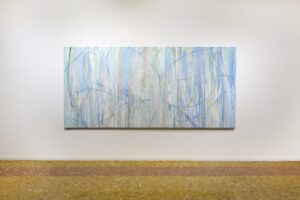
Luca Grechi, “Scrittura privata#2”, tecnica mista su tela, 166 x 350 cm, 2024, courtesy La Nuova Pesa, Roma
However, Grechi experiences painting akin to a mental discourse, so it’s obvious that sporadically he feels the need to give corporeality to what unexpectedly emerges from the canvas itself. The final appearance is an imperative and fascinating vision that solidly manifests itself solely for investigative and analytical purposes. This is evident when he works on Foresta (Forest), where the individual shapes of the bushes, moved by a light and graceful movement, emanate a placid tranquility, prompting rhythmic sensations and their corresponding connections. On this occasion, painting blossoms from the canvas not to become sculpture but rather as the protagonist artifact of a lively multidisciplinary dialogue, in relation to a primitive painterly note that captures the sensuality of a thicket. Even in the structure devised in 2020, titled Senza Tavolo (without table), whose surface paintings allude to frenetic journeys of clouds suspended in mist and tides dissolving, Grechi intends to capture a vision, this time delimiting the boundaries of an area created to accommodate a protected space. Nonetheless, the table is a boundary defining a non-place, rather devolving the certainty of finding in it a territory in which to cyclically experience one’s vision in variation to the spaces it occupies, as the artist assembles and disassembles it wherever he prefers.
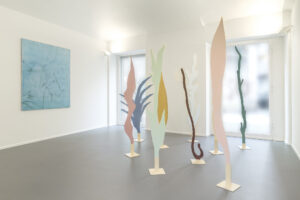
Luca Grechi, “Laggiù è qui”, installation view presso Davide Paludetto Arte Contemporanea, Torino, 2021, ph. credit Ludovica Mangini
Alternatively, condensing the discourse on environmental painting, the artist first establishes a specific relationship with the surface he works on, gently laying down a measured continuity of filiform fragments of varying density that touch and emerge only where the color allows. This is what happens in the primordial mural painting in Frasso Telesino, where, in continuity with the subsequent project at the Ante Operam exhibition in 2022, the cornerstone elements of all works originating from visions are anticipated, with the primordial and archaic aspect prevailing, deliberately open to continuous and unexpected modifications. It is self-evident to assume that Grechi conceives painting as an experience now consolidated, although still inaccurate incorrect: much like a vast mechanism in motion, a crossroads for assimilating and distributing energies and ideas. Then akin to a gentle and prolonged caress, the ultramarine blue tone of Frasso Telesino, the subject of studies in the years to come, absorbs without any violence everything that is traced on the underlying surface, proclaiming the sweet experimentation of a soft gradation so dear to him. Precisely this work anticipates his subsequent painting choices: acting on the void and chromatic sizing through shadows and planes of profiles, thus understanding painting as an autonomous form, allowing only a few suggestions to flash before the eyes.
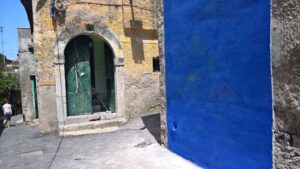
Luca Grechi, pittura ambientale, opera permanente, Frasso Telesino, Benevento, 2016, courtesy dell’artista
Nevertheless, the invisible writings of the work in Frasso Telesino traversing the epithelium of the surface with tremors and tensions prove that every work is a living thing, thus endowed with a web of capillary nerves. Thus, only several years later, the thin and light veils of color laid on the canvas finally visually emerge like in the nervous system of a human body, so that they mesmerize the artist who allows himself to be conquered by their delicate movement. Akin to a physical recoil on a Nerve, the moment when these motifs become the stimulus for an exercise in continuous deviation of fascinating veils is clearly defined. Only on such occasions does Grechi’s hand become so grave that it holds within itself the power of reflection, making it the motif of the entire life of the surface, fearlessly letting the ripples and iridescence fall away. Furthermore, over time, the artist has remained consistently committed to following a creative path aimed at expanding his horizons, thus mentally soaring over forests, seas, and islands, simultaneously nourishing his visual memory with insights and spontaneity. It is certain that he begins to paint when it seems he has already forgotten the place he had in mind, and in doing so, he gives life to a visionary painterly script characterized by vast and preliminary mental observations.
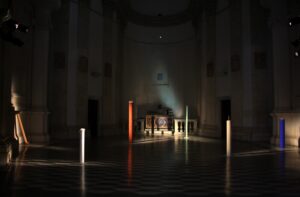
Luca Grechi, “Un sasso sul mare”, a cura di Isabella Vitale installation view, preso Sala Santa Rita, Roma, 2016, courtesy l’artista
This openness to unknown territories is also a moment of idealistic and dreamy synthesis that invites us to believe that for Grechi, in other words, an island is swirling in his head, to be understood not as a place, but again as the emergence of a vision still in the process of appearing. However, Grechi’s Island had already visually emerged years ago in the form of austere cylindrical structures embracing sea rocks, leading us to hypothesize that the relationship with this place is one of affinity rather than derivation. In these experimental phases, what allows each vision to acquire an expanded and tangible breath is the practice of drawing, where charcoal and charcoal dust represent an exercise of verification in relation to various ideas. They are a clear omen, a work in progress that defines the starting points for advancing new phases of one’s analysis. Yet, it is precisely in the forms of tangible natural buds that ambiguity hides: the gift of erasure that reveals the archaic and deliberately unfinished aspect. Nevertheless, from the examination of such papers, the humoral elements of an artist and his research emerge: sincerity, intimacy, love for defining a painting pregnant with a massive and convinced investigation begun years ago that must necessarily continue to never end.
Maria Vittoria Pinotti
[1] Italo Calvino, Cominciare e finire, in Lezioni Americane, Oscar Mondadori, 2017, p. 123
Info:
Luca Grechi. Manca sempre quello che sarà
22/02/2024 – 12/04/2024
La Nuova Pesa
via del Corso, 530, 00186, Roma
Opening hours: Monday to Friday from 10:00am – 1:30pm / 4:00pm – 7:30pm
nuovapesa@farm.it | www.nuovapesa.it
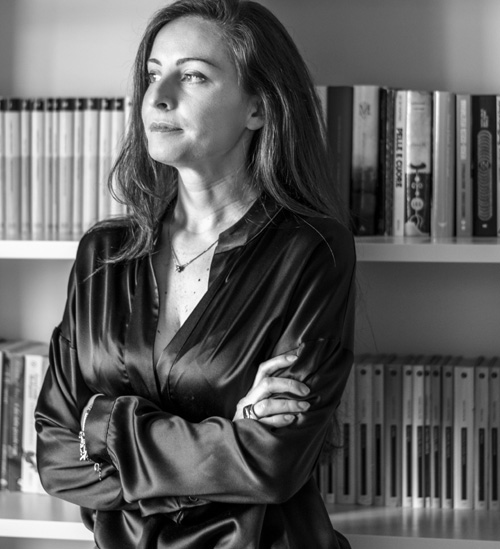
Maria Vittoria Pinotti (1986, San Benedetto del Tronto) is an art historian, author, and independent critic. She currently is the coordinator of Claudio Abate’s photographic archive and Manager at Elena Bellantoni’s Studio. From 2016 to 2023 she was the Gallery Manager in a gallery in the historic center of Rome. She has worked with ministerial offices such as the General Secretariat of the Ministry of Culture and the Central State Archive. Currently, she collaborates with cultural sector magazines, focusing on in-depth thematic studies dedicated to modern and contemporary art.






NO COMMENT